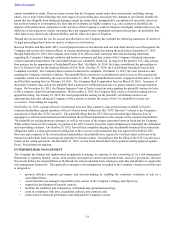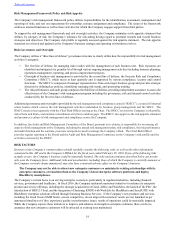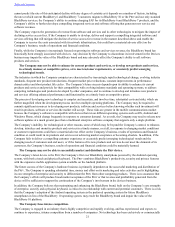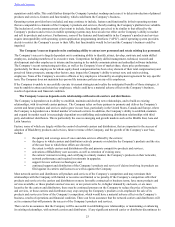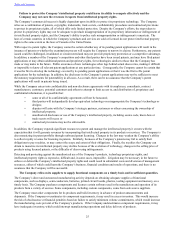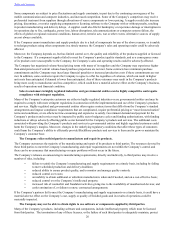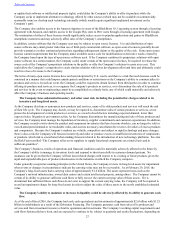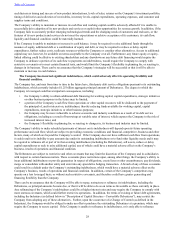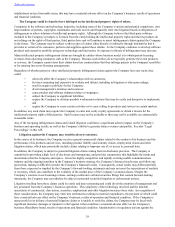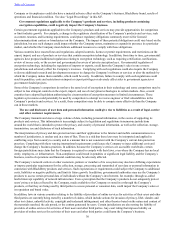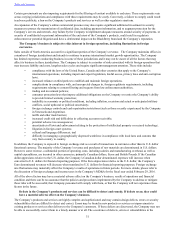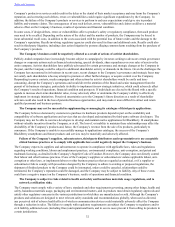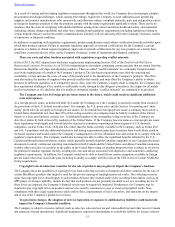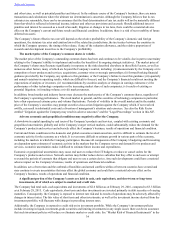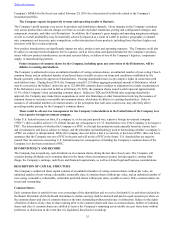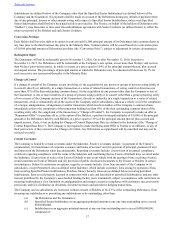Blackberry 2016 Annual Report Download - page 36
Download and view the complete annual report
Please find page 36 of the 2016 Blackberry annual report below. You can navigate through the pages in the report by either clicking on the pages listed below, or by using the keyword search tool below to find specific information within the annual report.
Table of Contents
27
or update their software or intellectual property rights, could delay the Company’s ability to offer its products while the
Company seeks to implement alternative technology offered by other sources (which may not be available on commercially
reasonable terms) or develop such technology internally (which would require significant unplanned investment on the
Company’s part).
The Company also enables access to the Amazon Appstore to users of the BlackBerry 10.3 operating system through a licensing
agreement with Amazon, and enables access to the Google Play store to PRIV users through a licensing agreement with Google.
The termination of either of these licenses would significantly reduce access to popular applications and games to BlackBerry
smartphone customers and may adversely affect sales of the Company’s smartphones.
In addition, certain software that the Company uses may be subject to open source licenses. Use and distribution of open
source software may entail greater risks than use of third-party commercial software, as open source licensors generally do not
provide warranties or other contractual protections regarding infringement claims or the quality of the code. Some open source
licenses contain requirements that the Company make available source code for modifications or derivative works created by
the Company based upon the type of open source software used. If the Company combines its proprietary solutions with open
source software in a certain manner, the Company could, under certain of the open source licenses, be required to release the
source code of the Company’s proprietary solutions to the public or offer the Company’s solutions to users at no cost. This
could allow the Company’s competitors to create similar solutions with lower development effort and time and ultimately could
result in a loss of revenue to the Company.
The terms of many open source licenses have not been interpreted by U.S. courts, and there is a risk that such licenses could be
construed in a manner that could impose unanticipated conditions or restrictions on the Company’s ability to commercialize its
products and services. In such an event, the Company could be required to obtain licenses from third parties in order to continue
offering its products and services, to re-engineer the Company’s products or services, or to discontinue the sale of its products
and services in the event re-engineering cannot be accomplished on a timely basis, any of which could materially and adversely
affect the Company’s business and operating results.
The Company faces substantial inventory and other asset risk, including the potential for charges related to its
inventory and long-lived assets.
As the Company develops or announces new products and services, many of its older products and services will reach the end
of their life cycle. The Company may decide, or may be required to, discontinue sales of certain products or services, or not
pursue the development of certain products or services, as a result of such factors including expected demand, lower than
expected sales, litigation or government action. As the Company discontinues the manufacturing and sale of these products and
services, the Company must manage the liquidation of inventory, supplier commitments and customer expectations. In addition,
the Company records a write-down for product and component inventories that have become obsolete, can no longer be sold or
exceed anticipated demand or net realizable value, and accrues necessary cancellation fee reserves for orders of excess products
and components. Because the Company’s markets are volatile, competitive and subject to rapid technology and price changes,
there is also a risk the Company will forecast incorrectly and order or produce excess or insufficient inventories of components
or products, which risk is exacerbated when making forecasts related to the introduction of new technology platforms. See also
the Risk Factor entitled “The Company relies on its suppliers to supply functional components on a timely basis and in
sufficient quantities”.
The Company’s business, results of operations and financial condition could be materially adversely affected in the future by
the Company’s ability to manage its inventory levels and respond to short-term shifts in customer demand patterns. No
assurance can be given that the Company will not incur related charges with respect to its existing or future products given the
rapid and unpredictable pace of product obsolescence in the industries in which the Company competes.
Under generally accepted accounting principles in the United States, the Company reviews its long-lived assets for impairment
when events or changes in circumstances indicate the carrying value may not be recoverable. As at February 29, 2016, the
Company’s long-lived assets had a carrying value of approximately $1.6 billion. The assets represent items such as the
Company’s network infrastructure, owned data centres and certain intellectual property, among others. The Company cannot be
certain of its ability to generate sufficient cash flows to fully recover the current carrying value of these assets. If it is
determined that sufficient future cash flows do not exist to support the current carrying value, the Company will be required to
record an impairment charge for long-lived assets in order to adjust the value of these assets to the newly established estimated
value.
The Company’s ability to maintain or increase its liquidity could be adversely affected by its ability to generate cash
flow.
As of the end of fiscal 2016, the Company had cash, cash equivalents and investments of approximately $2.6 billion with $1.25
billion in indebtedness as a result of the Debenture Financing. The Company generates cash from sales of its products and
services and from investment income to fund its operations and investments. The Company’s working capital requirements and
cash flows historically have been, and are expected to continue to be, subject to quarterly and yearly fluctuations, depending on



